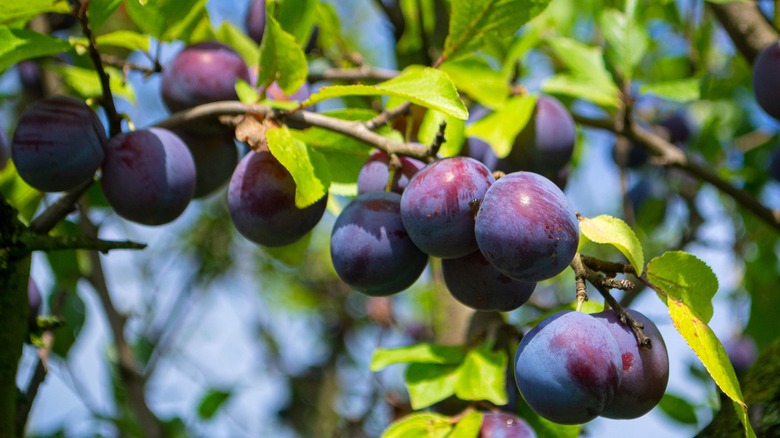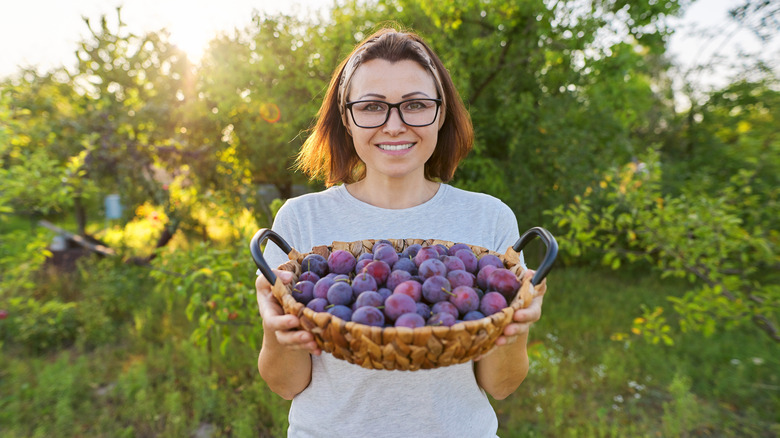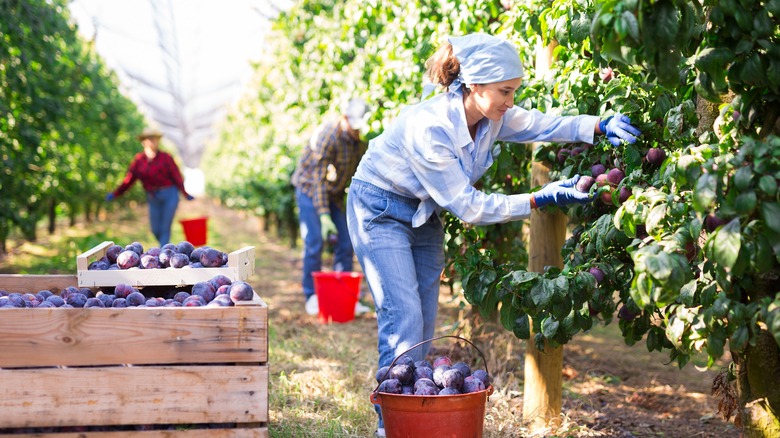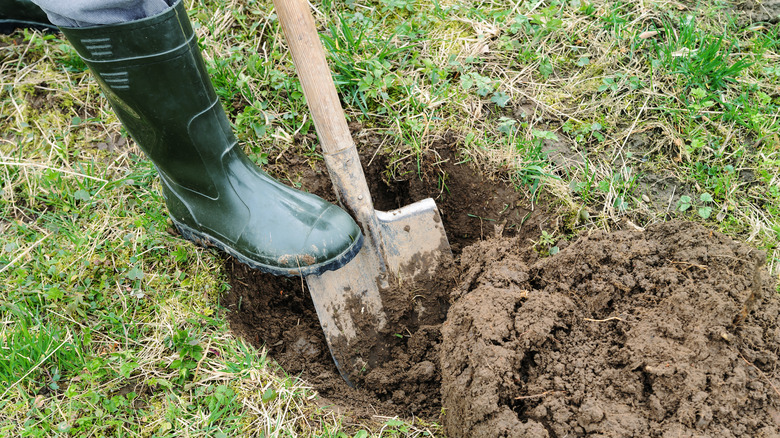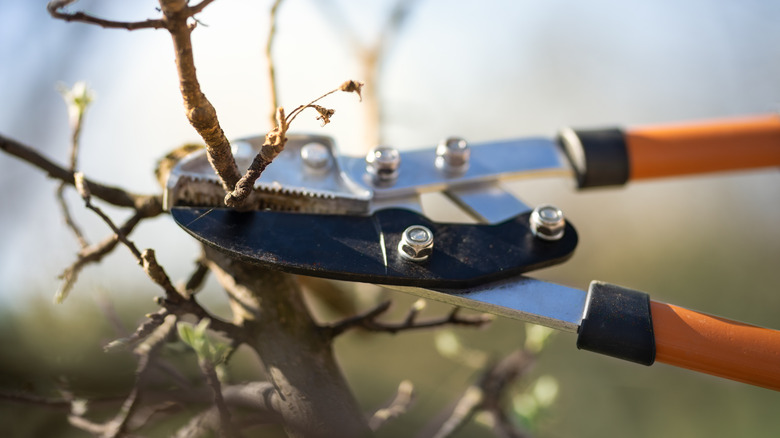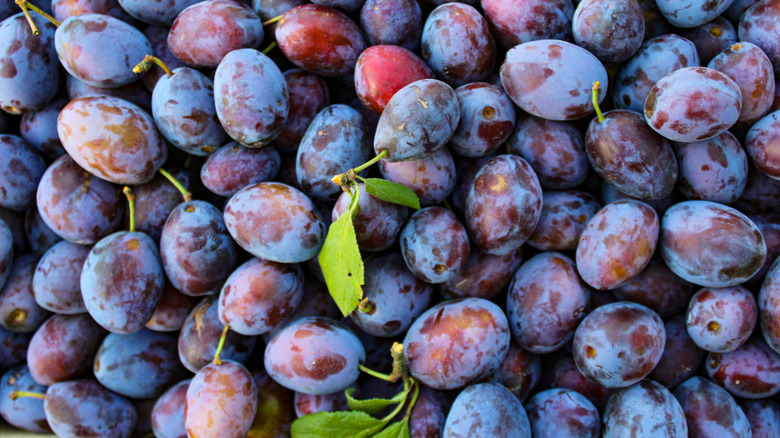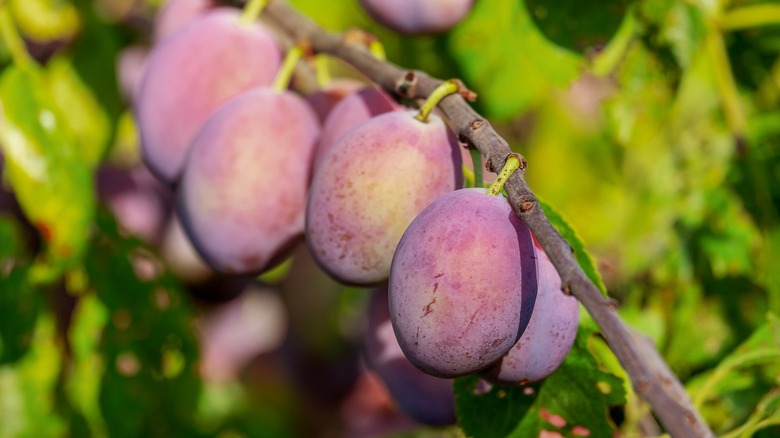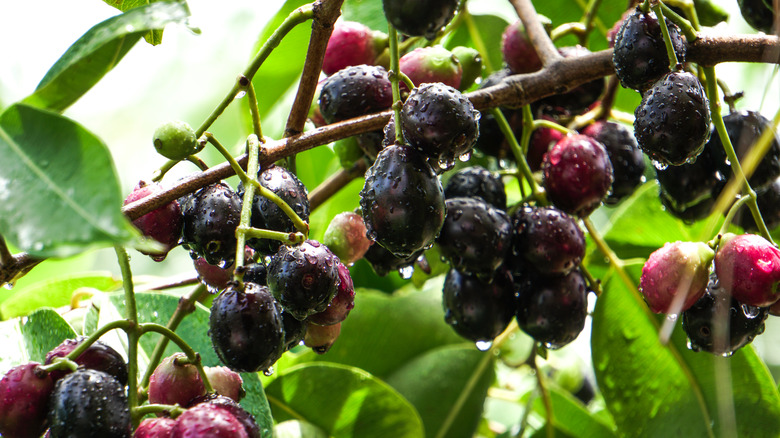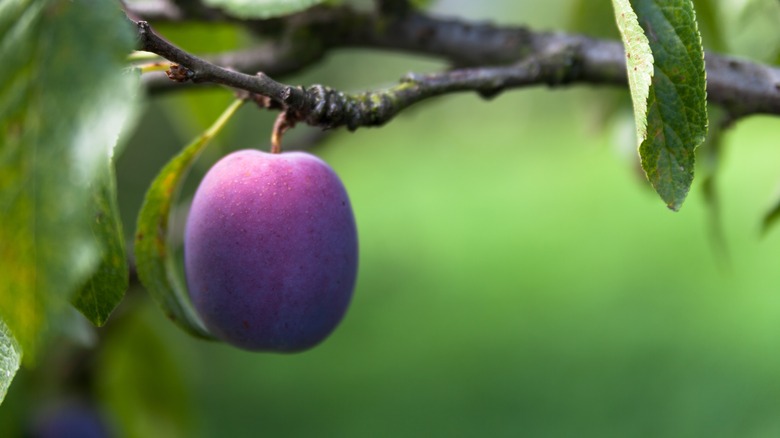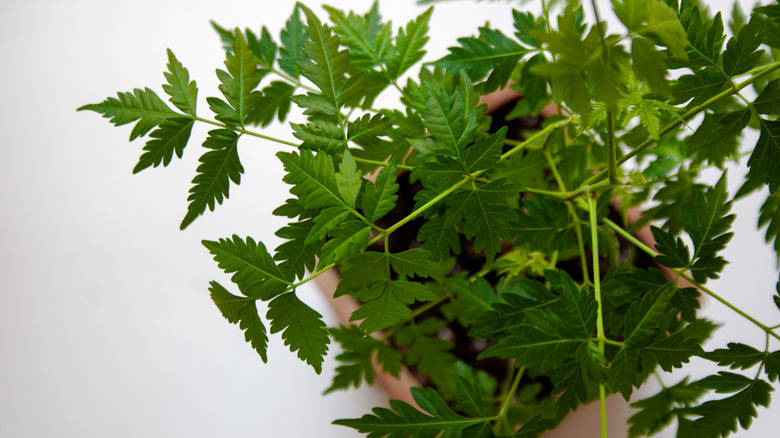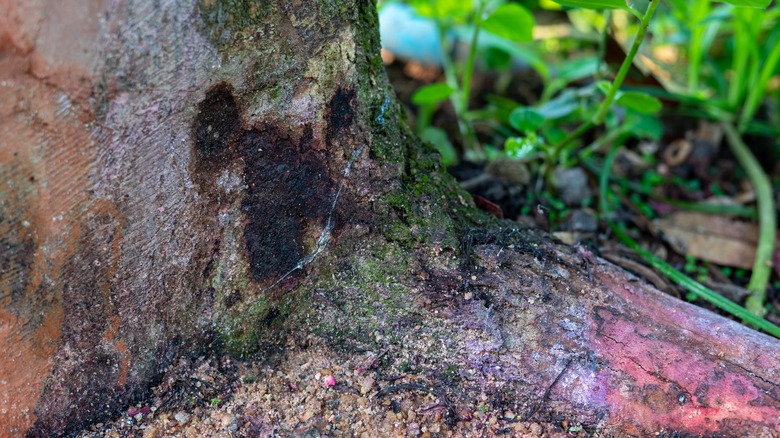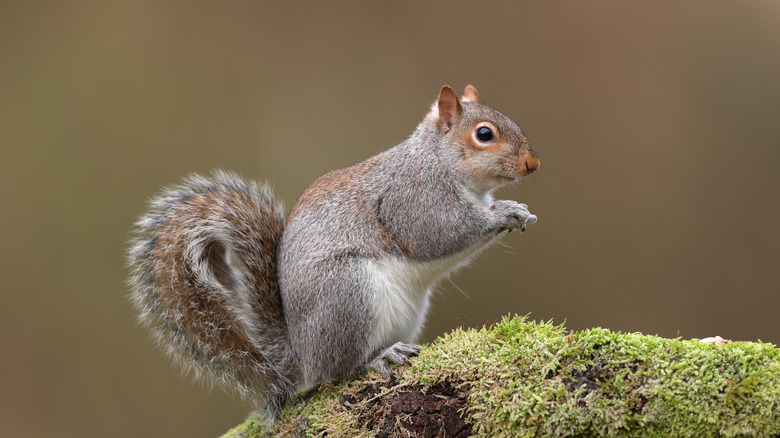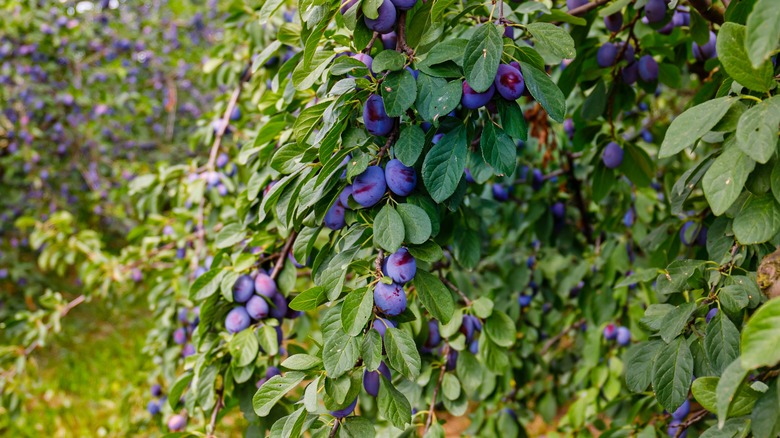Plum Tree: Everything You Should Know Before Planting
A plum tree, also known as Prunus domestica, is a beautiful, blossoming tree that produces a plump and juicy fruit commonly known as a plum. Although Nature & Garden states that no one is certain exactly where plum trees originated, we can prove plums date all the way back to the Bronze Age. Egyptians placed prunes, or dried plums, in the tombs under their pyramids, and plums also played a popular role in France during the Middle Ages and Renaissance. Today, plums continue to grow as a hybrid breed of both European and Asian plum trees.
According to Love To Know, most plum trees grow between 10 and 15 feet tall. Some, however, have been recording to make it up to 20 feet tall. Although the main purpose of plum trees is to harvest their delicious fruit, they can also make beautiful ornamental trees. The oval-shaped, serrated leaves range between 2 and 4 inches and boast a wide range of colors, like green and purple in the spring and yellow, red, orange, and purple in the fall. In the spring, before their fruit emerges, their branches also ignite with tiny white flowers. If you're interested in adding a beautiful and delicious plum tree to your garden, this guide will provide you with everything you need to successfully grow and care for this tree.
How to use in your garden
The best part about having a plum tree in your garden is the delicious fruit it will provide you with. Plum trees produce a type of stone fruit, commonly known as a plum. According to Medical News Today, plums can come in a variety of sizes and colors and are packed with a variety of nutritional benefits. They are low in calories and fat content and contain a high amount of nutrients, like potassium, magnesium, and vitamin A. They can also be enjoyed in various ways, whether fresh from the tree, dried, or even turned into jam.
Other than producing a nutritious and tasty treat, these fruit trees can also light up your garden with their ornamental beauty. Depending on the specific type of plum tree you possess in your garden, the spring will cause your tree to ignite with tiny purple or pink blossoms that can bring color and beauty to any garden or landscape (per Gardenerdy).
How to grow a plum tree
Plum trees are a beginner-friendly way to add a delicious edible touch to your garden at home. To plant your own plum tree, MasterClass recommends planting your seeds between the late winter and early spring months straight into your garden for the best results. This allows the seeds to naturally overcome their dormancy without facing the further shock of transplanting, which occurs when a plant is transferred from a potted environment to a permanent position in your yard.
When planting directly into your garden, however, the spot you choose is very important for the health of the tree and the fruit it produces. MasterClass states that the position you choose should be a full sun position because the more sun your tree receives, the juicier the fruit will be. An ample amount of space should also be available in the given position to both allow the tree space to grow with the addition of extra space in case another tree needs to be added. Another tree will need to be added if your current tree is not self-pollinating. In this case, the two trees can pollinate each other, allowing them both to bear fruit.
How deep do you need to dig to plant a plum tree?
Before you begin actually planting your tree, Rural Sprout suggests creating a plan based on the conditions within your space. You want your tree to be planted in a specific spot where it can thrive, taking into account sunlight, water flow, soil type, and the other plants in the area. Then, select your new plum tree and prepare the planting area. The size of the hole should be deeper than the roots. Make sure it's triple the width of the root system, and spread them out as much as possible in the space. Add organic matter to stabilize the tree and stake it if it needs extra support. Be sure to adequately water the freshly planted tree if rain isn't in the forecast.
If you've never had your yard marked for utilities and aren't sure where your lines run, you'll want to call a few days before planting (via Call 811). This service sends a representative from each utility company in your area to your home to mark where their lines run in your yard. That way, you can avoid these lines while digging and prevent outages or electrical shock. This is a vital step in planning where to plant your plum tree as well as planning your yard's landscaping layout.
How to care for a plum tree
After your plum tree begins to grow, it's important you know how to properly care for the plant so it stays strong and produces fruits for as long as it can. Luckily, according to MasterClass, plum trees do not require much maintenance to stay healthy and strong.
After first planting your plum tree, it must receive plenty of water as the roots develop. With one heavy watering a week for the first year or two, you can ensure your roots grow strong, healthy, and deep into the ground. To keep pests and diseases away from your plum tree, it is also recommended to give your tree one good pruning every year. When it comes to pruning, never prune your trees during the fall or winter to avoid unwanted winter damage. To further assist your tree's growing and blooming process, MasterClass also recommends using fertilizer once a year in the early spring. When using fertilizer, however, ensure it is an all-purpose fertilizer or a form of aging compost, and never apply any type of fertilizer after your tree's fruit begins to grow.
How long will it take for trees to produce plums?
My Perfect Plants points out that it takes about three to six years for plum trees to be established enough to bear fruit. This could happen sooner in earlier yielding varieties. As the tree grows older and larger, so will the size of the plums it produces. If your tree seems delayed, you might have a pollination problem. It's best to have another variety of flowering plum trees planted within 50 feet so they can successfully cross-pollinate.
Improper growing conditions can also cause issues with fruiting. Make sure you plant your trees where they will get at least eight hours of sun daily. Keep in mind that they also require a chilling period over the cool months to prompt them to bloom again in the spring. Do your research to find a variety that will work best in your area, especially if you live in a warmer climate.
Plum trees need a good watering once a week, so you might need to supplement during dry spells. However, overwatering can also have adverse effects, making the trees susceptible to fungi. So, watch for signs of infestations or rot and water at the base, not on the leaves. Fertilizing can also boost your tree's health and improve fruiting. Look for a high-phosphorus option like bone meal, but avoid excess nitrogen that can cause flowering issues.
How long can a plum tree live?
According to Modern Farmer, the average lifespan of a plum tree is about 10 to 25 years. Dwarf varieties will live for the lower end of this range, while you will likely get more life out of full-size varieties. This is a lower range than common fruit trees like pear and apple, but proper care can give your plum tree the best chance at a longer lifespan.
If you notice your plum tree failing to thrive and dying off, you can attempt to revive it (via Plantophiles). Spray your tree to remove any damaging insects or fungi, and inspect the leaves to make sure your tree is getting plenty of water. If they are wilting, water the tree deeply and more frequently. Take care to remove damaged or dying branches that can spread issues throughout the rest of the tree. If you are still struggling to revive your dying tree, you can call a professional horticulturalist to assess its condition and create a care plan.
Plum tree varieties
According to Minneopa Orchards, hundreds of plum tree varieties are grown worldwide, ranging in various colors, sizes, and flavors. Let's take a closer look at some of the plum tree varieties you can incorporate into your garden.
- June plum trees (Spondias dulcis) are a fast-growing variety of plum trees that emerged from the South Pacific and produce a large green fruit instead of the traditional small, purple fruit.
- Victoria plum tree (Prunus domestica) was named after the queen in Victorian England and is still widely enjoyed throughout the United Kingdom.
- Flatwood plum trees (Prunus umbellata) can also be known as the Hog or Sloe plum due to their natural growth in the wild. Similar to the wild plum, their fruit is better preserved or caked rather than eaten raw.
- Sour plum trees (Prunus mume) produce a green fruit that is sour and crunchy and can be found in a wide ranch of Asian dishes and drinks.
- Thundercloud plum trees (Prunus cerasifera) are plum trees that produce both beautiful bright pink flowers and delicious reddish-purple plums that are soft, sweet, and tart.
- Java plum trees (Syzygium cumini) are unique plum trees that grow up to 100 feet in a tropical environment and produce a rather small, dark fruit compared to other plum trees.
Are plum trees toxic?
As you already know, plum trees produce fruits called plums, which are commonly eaten, in various ways, by people all over the world. Minneopa Orchards confirms that dogs can also indulge in the fruit as a tasty and nutritious treat. On the other hand, cats are warned to stay away from plums due to the risk of cyanide poisoning and the unhealthy drop in blood pressure (per Minneopa Orchards).
Other than the fruit itself, you also need to pay special attention when it comes to the leaves, stems, and seeds of your plum tree, as well. ASPCA mentions that these elements of a plum tree can cause harm to common house pets, especially when they are in the process of wilting due to their high levels of cyanide, which can harm your pet. You can recognize cyanide poisoning in your pet if they are having difficulty breathing or panting, their pupils are dilated, and they seem in overall shock.
How to repot a plum tree
When growing a plum tree from a seed, you may decide to grow it in a pot instead of outside in your garden. A pot allows the tree to grow in a controlled environment without the many risks an open garden poses. When growing your plum tree in a pot, however, you do have to consider transplanting your tree into bigger pots as it continues to grow bigger.
When transplanting a plum tree, Green Universe states that you must ensure the soil in the new pot has good drainage to allow the roots to easily adjust and grow in the new pot. To start the transplanting process, add a bit of soil to the bottom of the new pot and remove the plant from the old pot by gently wiggling it free. Then, simply place it inside the bigger pot and fill in the soil around it. Pat the soil down firmly and finish off with a heavy watering. The plant may be in shock for a while after the transplant, but once it adjusts to its new surroundings, it will start to grow again.
Common diseases
Although plum trees are known for being very easy to grow and maintain, Epic Gardening states that they are still susceptible to a variety of bacterial, fungal, and viral diseases that may sweep through your garden. One bacterial disease, in particular, is known as Bacterial Canker, which grows on the stems of your tree and affects the growth of leaves on that stem. Bacterial diseases like this, however, are very easy to prevent by simply keeping your tree healthy and in the right condition. Pruning is the best-recommended treatment to get rid of a bacterial disease that has already started to grow.
Fungal diseases, like Armillaria Root Rot and Black Knot, tend to emerge during the cold and rainy seasons and can affect a variety of different parts of the tree. Although some fungal diseases can be manually removed by pruning, fungal diseases are most commonly treated with fungicides. Finally, viral diseases like the plum pox virus can also affect plum trees. The plum pox virus, in particular, mainly only affects the fruit of the tree by causing grey rings on the surface of the fruit. Although, like most diseases, a viral disease can easily be prevented by keeping your tree healthy and in the right condition, there is no cure once your tree attracts the plum pox virus. Getting rid of the disease involves completely removing the tree.
Watch out for damage from mammals
Various mammals can cause significant damage to your plum tree. Even though these animals are typically small in size, their efforts can wreak havoc on your tree's health. As Forest Research points out, your tree can be vulnerable at every stage of its life, so inspect it regularly to prevent damage. Mice, voles, and more can build nests under trees and affect seedlings and root systems. Squirrels and rabbits can damage bark and cause issues to mature trees. And if you have deer that wander into your yard, they can nibble on foliage and fray your tree's bark.
To prevent climbing animals from scaling your tree, you can install metal flashing snuggly around the trunk (via The Mercury News). Baffles can also be installed under the bottom branches to prevent climbers from accessing the fruit and foliage. To protect the entire tree, you can cover it with a layer of netting or mesh. As an additional measure, hang moth balls in mesh bags from branches or spray a spicy substance to make your tree less appealing to rodents. Make your own by combining water, dish soap, and hot sauce, then spray your plum tree regularly to deter these damaging pests (via the University of Maryland Extension).
When you should start thinning your plums
Thinning your plums and reducing the number of fruit on your tree may seem counterproductive. However, it's one of the best strategies for cultivating better long-term yields. As Oregon State points out, thinning can boost the size of future plums and prevent too big of a crop that will reduce the crop size the following year. Plus, too many heavy-hanging fruits can weigh down fragile branches and cause breakage.
When thinning the fruit on your plum tree, you will want to do it within 30 days of spring's final blooms. The trees also self-thin and drop some of their fruit on their own at the beginning of June. It's a good idea to leave extra fruit to account for this and thin more later if too many remains. Keep an eye out for drooping limbs as the fruit matures and grows heavier. If they droop, reduce the number of plums or use supports to prevent breakage.
